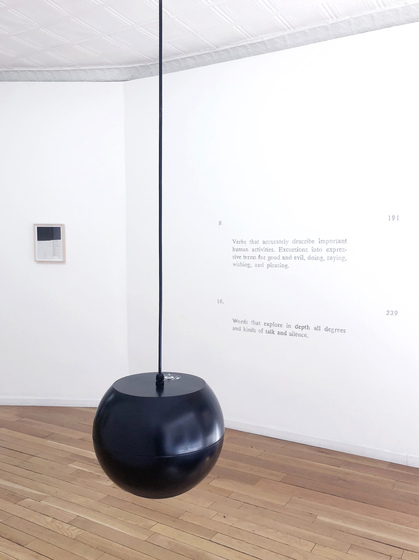-
From Current Issue
-
- Editor’s Letter Fire in the Heart
- Reviews I Gusti Ayu Kadek Murniasih
- Reviews 11th Seoul Mediacity Biennale: “One Escape at a Time”
- Dispatch Networked China
- One on One Monira Al Qadiri on Yukio Mishima
- Essays The rise of independent art spaces in pandemic-era Shanghai
- Features Tuan Andrew Nguyen
- Table of Contents
- Web Exclusives
- Archive
- Subscribe

R
E
V N
E
X
T
Installation view of JESSE CHUN’s “Name Against the Same Sound,” at Baxter Street at the Camera Club of New York, 2018. All images courtesy the artist and Baxter Street at the Camera Club of New York.
Name Against the Same Sound
Jesse Chun
Although Jesse Chun’s “Name Against the Same Sound” at Baxter Street at the Camera Club of New York revolves around the artist’s investigations into the mechanics of learning a language, namely English, one would be missing the point if one were to read the works solely through this premise. More importantly, Chun’s interdisciplinary exhibition delves into language as form, sound, writing and a process of subjugation in the context of a non-native speaker assimilating to a culture.
Upon entry into the gallery, one is greeted by Drawing (I Write Well) (2018), a site-specific drawing with graphite. The fact that the work is drawn and not written is essential—although depicting words, they are not transcribed, but rather visually represented. Graphite marks accurately trace a typeface from an English language workbook, also referred to with the work’s inclusion of page numbers. The drywall surface lends a subtle, bumpy and shaky texture to the represented text, which adds a self-conscious quality to the work. Contradicting this earnestness is the ethical self-righteousness manifested in the sentences. The first sentence reads: “Verbs that accurately describe important human activities,” as well as “terms for good and evil.” The student using this workbook is asked to, in a foreign language, think about what would constitute an “important” human activity, and the underlying morality behind ruminating on words for “good and evil.”
While Drawing explores the written component of learning a language, Sound Natural (2018) tackles the aural element. A female and male voice, appropriated from Youtube language tutorials, sound out English vowels. The voices seem to respond to each other as if in a coded conversation. The sound is emitted from low, hanging speakers. To listen very closely, one may have to bend their body—as one does when trying to make out the words of a child—a posture that is simultaneously of vulnerability and authority.
The audio of Sound Natural serves as a sound track for the viewing experience of the drawings in this show, such as No On Ou No (2018), a small pigment print on a linen decal directly adhered onto the gallery wall. The background, featuring turquoise-washed clouds, is reminiscent of cover designs of educational books, added to by the work’s A4 paper size, which gives it the physical presence of this type of document. Layered atop is a concrete poem based on the word “no,” which is mirrored, repeated and spread across the background. The reversing makes “no” read as “on” and, upside down, “ou.” The “no’s” recall the parts of a self that are lost as one is learning English, the “no’s” of the physical fissure caused by traveling across skies, leaving one’s home and going elsewhere, and perhaps also suggests resistance against the hegemony of English.
JESSE CHUN, (left) No On Ou No (II), (2018), pigment print on linen decal, 28 × 21.6 cm. (Right) Name Against the Same Sound, 2018, pigment print, 127 × 76 cm.
Concrete poetry takes a different form in Workbook (2017), a single-channel video installation comprising a television screen installed within a backdrop of vinyl lettering forming a workbook page’s layout. Beginning with a digitized piano tune composed by Johann Sebastian Bach, the video feigns the appearance of a language tutorial. Divided into four chapters: pronunciation, listening practice, intonation and vocabulary, Workbook looks directly into English language pedagogy within the framework of the various technological interfaces through which this knowledge is distributed. Most recognizable is the two rectangular fields of Google Translate. Rather than words, letters (both from Hangeul and English) are inserted, leading to futile translations. The raw text box becomes filled with a black-and-white clip of ocean waves, while the English translation box goes off into a monologue using a combination of the letter “o” and zeroes. Reminiscent of the repetitive vowels in Sound Natural as well as the repetition of “no’s” in No On Ou No, conversation in Chun’s work is reduced to the primal or the esoteric, as often happens when one encounters a new language. One either resorts to childish babble or stiff, memorized phrases.
Chun constantly shifts between language that is read, seen, spoken and heard. Just as one begins to read and make sense of the words, they are transformed into mere form, as if to take the viewer back to a time before comprehension, and vice versa. Though the raw and sometimes hard-edged aesthetic of these works could, to some, come across as unsettling, they are not without poetry and hopeful possibilities for the future. Heard through the rigid voice of the video tutorial clip in Workbook, Chun asks, “Which direction should I go in? … Our thought is not finished yet.”
Jesse Chun’s “Name Against the Same Sound,” organized by Howie Chen, is on view at Baxter Street at the Camera Club of New York until April 14, 2018.
To read more of ArtAsiaPacific’s articles, visit our Digital Library.





